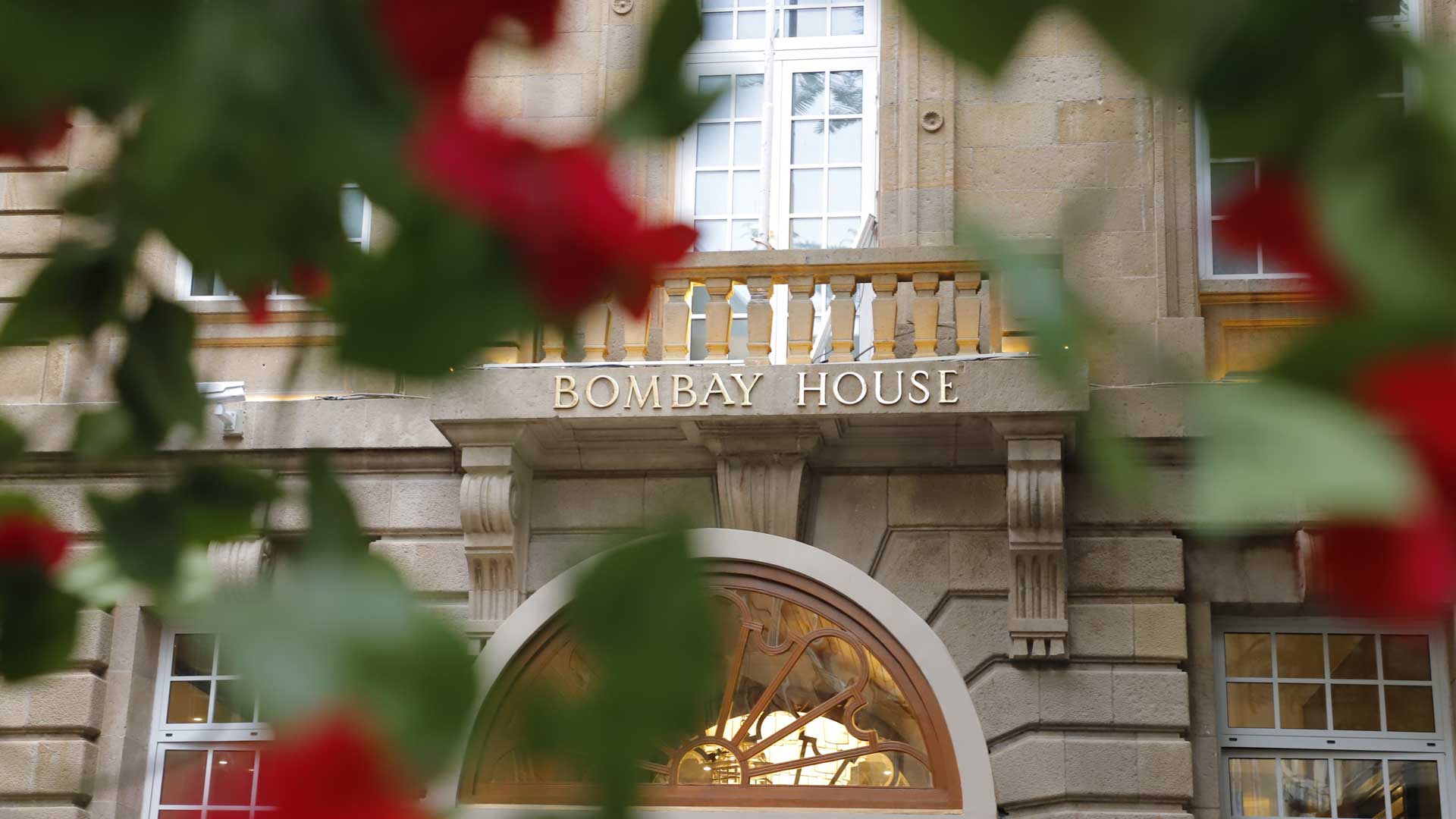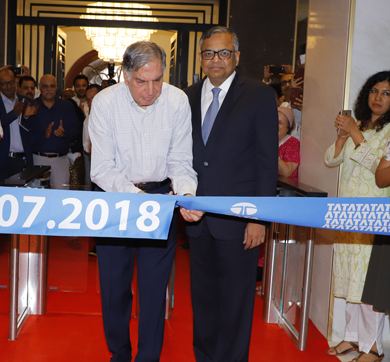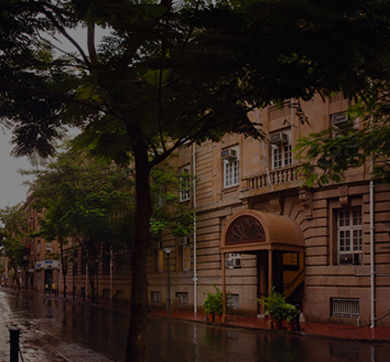September 2018 | 1892 words | 7-minute read
On May 30, 2017, the Chairman of Tata Sons, N Chandrasekaran, called me for a meeting. He told me that Tata Sons intended to refurbish Bombay House — for the first time in its 94-year-old history.
The date given to inaugurate the restored and refurbished headquarters of the Tata Group was July 29, 2018, JRD Tata’s birth anniversary. This time constraint made the task an almost impossible one, but a task that had to nonetheless be embraced. It was a once-in-a-lifetime project.
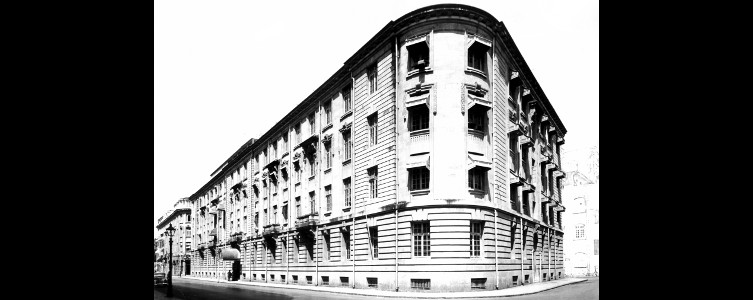
Flashback: The Original
The Bombay House story began when the Tatas purchased a plot of land, measuring 21,273 square feet, put up by the Bombay Municipality in 1921. Plans for the building were conceived by the Scottish architect George Wittet, who at one time was the consulting architect to the Government of Bombay and later joined the Tatas as the head of Tata Engineering Company Ltd. By then he had already designed the city’s iconic Gateway of India.
The construction of Bombay House was completed in July 1924. The headquarters had four businesses functioning within — textiles, hotels, steel and power — under the leadership of Sir Dorabji Tata. By 1942, the Tata group had grown and a fourth floor was added to Bombay House.
The Concept
It was the Chairman’s vision, incorporating his idea of One Tata, that sparked the concept behind the new Bombay House. He was clear that he wanted the refurbished building to be a youthful and vibrant space for the users, with integration of technology, introduction of interactive and agile spaces and chronicling of the group’s 150-year history in dynamic and innovative ways. He wanted it to be relevant to 2018 and beyond.
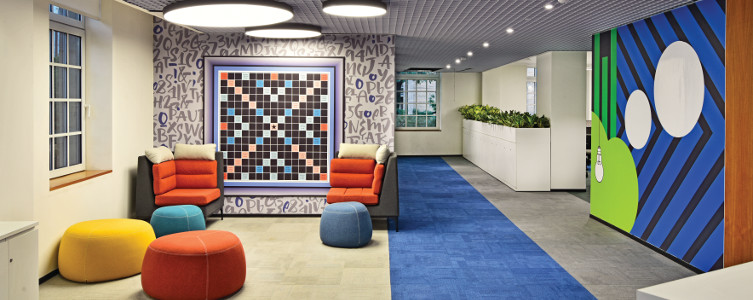
To fulfil his vision, it was important to interact with all end-user entities. The first five months after Somaya and Kalappa Consultants were formally appointed to lead the project comprised meetings with stakeholders to understand their individual requirements as well as technical and procedural aspects like non-destructive testing, visual structural inspections and obtaining statutory approvals.
This project gave us the opportunity to work beyond architecture and design and immerse ourselves into telling stories about the Tata group’s past, present and philosophy of the future.
We carried out extensive research, visiting several archives in Mumbai as well as the Tata Central Archives in Pune and Jamshedpur. Finally, it was the words of the founder Jamsetji Tata — “what advances a nation is not so much to prop its weakest and most helpless members, but to lift up the best and the most gifted so as to make them of the greatest service to the country” — that gave us the foundation upon which to begin the narrative.
The design was conceptualised in a floor-wise manner depicting the chronology of the Tata group — its “Evolution, Reflection and Metamorphosis”. It was executed retaining the elegance inspired by the architectural vocabulary of the building itself.
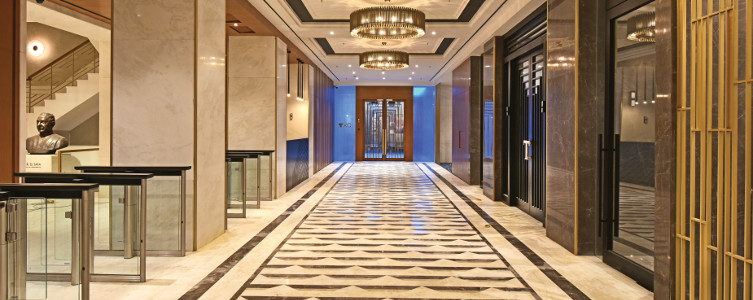
Various Tata institutions were approached for archival mixed media content, including photographs, vintage advertisements and memorabilia. This was collated with narratives that reflected the group’s pioneering efforts, trustworthiness, community initiatives and contributions towards nation building. These visual narratives have been displayed in the corridors, lounges and common spaces as a thread that runs through the building.
The basement and ground floor depict the group’s inception and evolution, giving the visitor an introduction to the Tatas’ history, philosophy and contribution to nation building.
It is interpreted through the detailing — from the linearity of the veneer on the corridor walls to the brass trees in the 1903: Lounge (the Taj Mahal Palace, one of the founder’s dream projects and the only one he lived to see, opened in 1903). The trees are a metaphor representing the ideas of Jamsetji Tata emerging from the roots and spreading out through the branches to the rest of the group companies.
The Chairman was also very clear that the ground floor would contain common spaces and not offices. We incorporated this with the lounge on the western side and the Tata Experience Centre (TXC) on the eastern side. The chairman also wanted the TXC to be for all; not just special visitors or the Tata group. He was keen that it work in an educational manner for students and the youth who may not have had the opportunity to see and hear the story of the Tata group and what lies ahead.
The fact that the ground floor spaces have now become a shared space for the Tata group and, in a way, for the city of Mumbai at large is what is going to make Bombay House even more special.
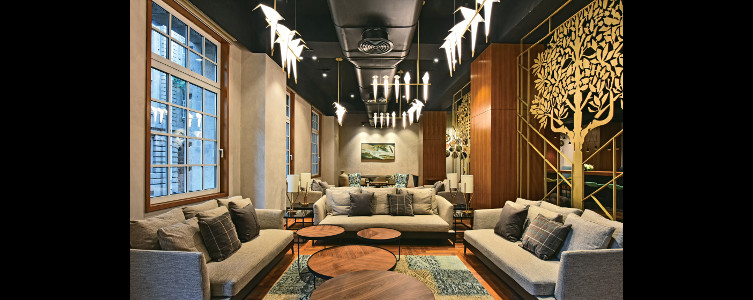
The first, second and third floors hold the offices of leading Tata companies, reflecting the leadership, integrity and ethics of Tata Sons — thus the concept of 'reflection'.
The first floor houses Tata Chemicals, Tata Power and Tata Industries, while the second floor houses Tata Steel and Tata Motors. The third floor houses Tata Sons. They have been designed with break-out spaces and informal lounges with bursts of colour and graphics to create a vibrant work environment and promote interaction among its users. A dedicated corner within every office space has been converted into a ‘think-pod’ with agile furniture to inculcate innovative thought and exchange of ideas.
A variety of technologically advanced meeting rooms are provided on each floor. Any company across all floors can use them, allowing for more fluid usage of spaces and encouraging people to move around the building and not be contained to single floors and their designated offices. This was planned to nurture integration and interaction between companies, representing the idea of One Tata.
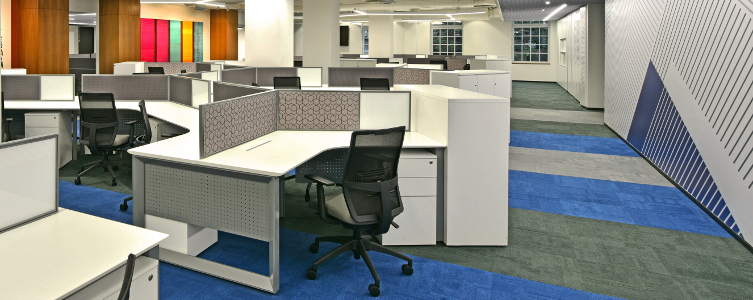
The fourth floor is conceptually developed as the metamorphosis. As the executive floor, it holds the offices of the Chairman and the boardroom. It is where the future of the company is built.
The work on this floor was carried out without disturbing its heritage value. A key element of this was keeping the historic boardroom table exactly as it was instead of turning it into a contemporary table, which typically has a lot of technology worked into it. The table has been polished and brought back to its original condition just like the panelled walls and the original windows of the boardroom.
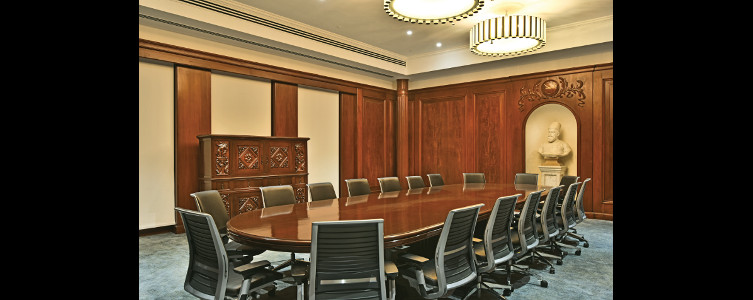
Just 7 Months
On December 15, 2017, the contractors’ mobilisation began on site. The team of dozens of consultants with a combined labour force of over 800 people had just seven months to complete the project.
To ensure sensitive restoration of a Grade II heritage structure like Bombay House, it is vital to understand the type, condition and true nature of the materials prior to the finalisation of the conservation plan. Mock-ups for all typologies of façade restoration works were carried out before execution.
The Malad stone façade was cleaned using specialised methods that included both dry and wet cleaning, depending upon the requirements. Other façade stone details and deep cornices were cleaned using the method of paper poulticing.
Careful execution of biological growth and paint removal, mortar repair, dutchman repair and removal of existing pointing was also undertaken. The original lime pointing of the stone joints had deteriorated over the years. Patchwork repair of the pointing had been done in cement, which is an incompatible material for the stone masonry and prevents the masonry from breathing. The damaged pointing was removed and repointing was done in lime.
Existing windows with Georgian bars were redesigned as double-glazed windows to curtail external noise (a reduction of approximately 40 dB). This also helped in reducing the air conditioning load.
External lighting was introduced to highlight key neoclassical elements of the façades. This and the need for security and surveillance meant that the wiring routes for the cameras and the external lighting had to be plotted to ensure minimum visibility of the cables. It was done by running all the cables along the edges.
One of the main challenges of the façade restoration was to relocate external service lines internally. Service line interventions like plumbing, sanitation and air conditioning had occurred organically over the years and resulted in damage to the façade. The design and layout of the external rain water downtakes was also reworked to minimise their numbers on the external façade.
The remedies for the structural restoration were proposed by the structural consultant based on the results of the non-destructive tests that were carried out to determine the condition of the structure of the building. These included a wide range of waterproofing and repairs from the basement slab and wooden framework repairs to the terrace.
All roof members were inspected in detail. The damaged purlins were retrofitted with mild steel plates and damaged wooden boards replaced. Anti-termite treatment was carried out post restoration. A new system of waterproofing called the ‘Double-Batten’ was introduced to provide two layers of protection. Keeping in mind fire safety requirements, all the roof members were also painted with fire retardant paint.
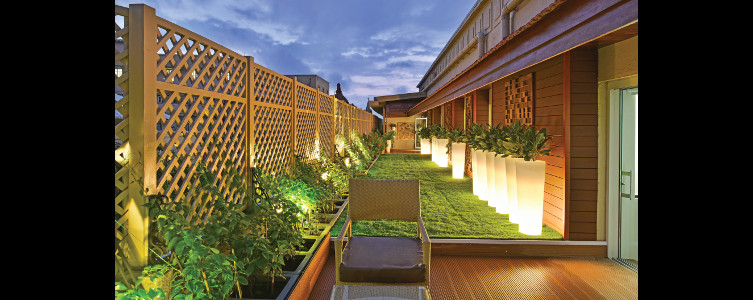
The landscaped terrace was revitalised introducing greenery interspersed with outdoor seating. Services that were spread all along the terrace were integrated allowing for levelling, thereby creating single contiguous spaces that could now be utilised.
The structural restoration also included reconstruction of the barrel vault roofs of the three entrance canopies and the expansion of the main entrance on the southern façade, creating a relatively grand sense of entry that did not exist earlier.
The Kennel
It was important to honour the existing customs of Bombay House, and dogs had been an integral part of the building for a long time. We had to ensure that they were given a dedicated space, so a kennel was incorporated. A bright, vibrant space with wall graphics, dog beds and feeding and bathing facilities required to care for them was provided. An access dog panel was designed at the base of the door to allow them to enter and leave at will.

Not Just Bombay House
The process of reviving Bombay House also extended to the public realm. Concrete pavers were used for the pavements around the building on Homi Mody Street. The finishing materials chosen were more sympathetic to the stone façade in colour and texture. They also allow for rain water lines to run below the pavement.
Through the seven months it took to finish all this, the team had one goal in mind: deliver the highest quality, reflecting the values of the Tata group. On time.
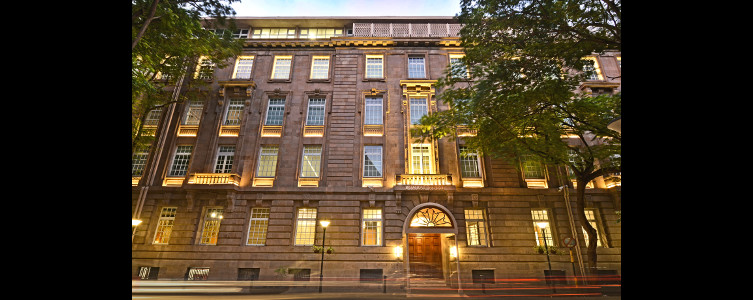
The words of Andrew Carnegie — “Team work… is the fuel that allows common people to attain uncommon results”— capture the essence of this project accurately. The Chairman entrusted us with the impossible, and together we delivered a building worthy of the House of Tata.
Author Brinda Somaya, architect, helmed the renovation of Bombay House.

